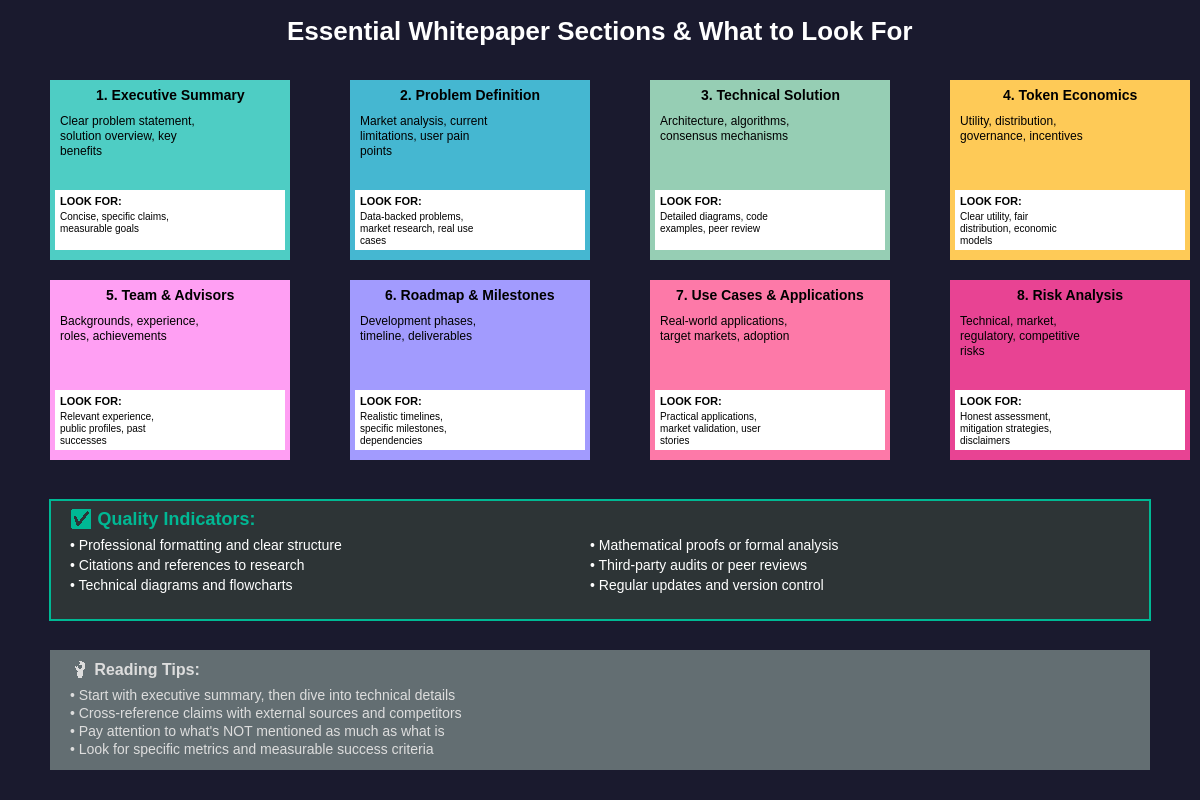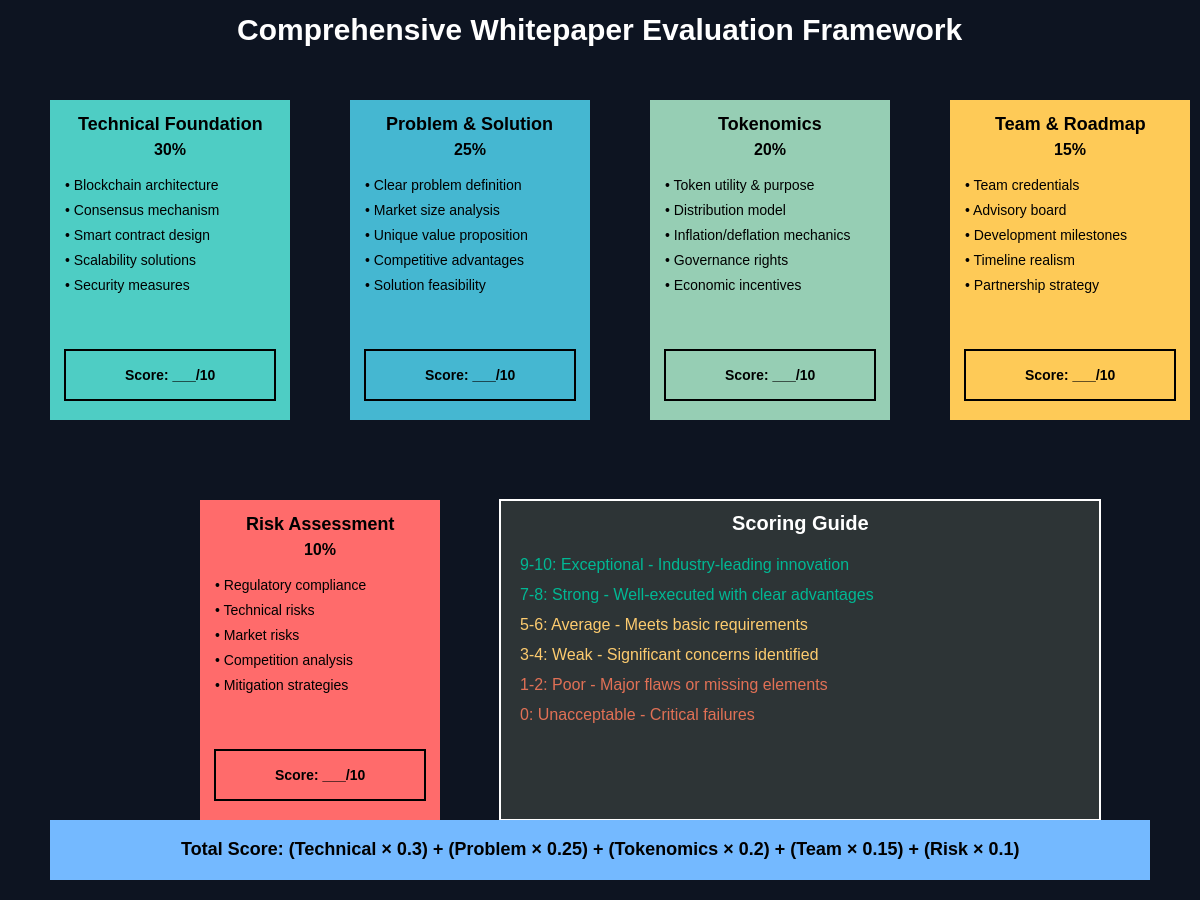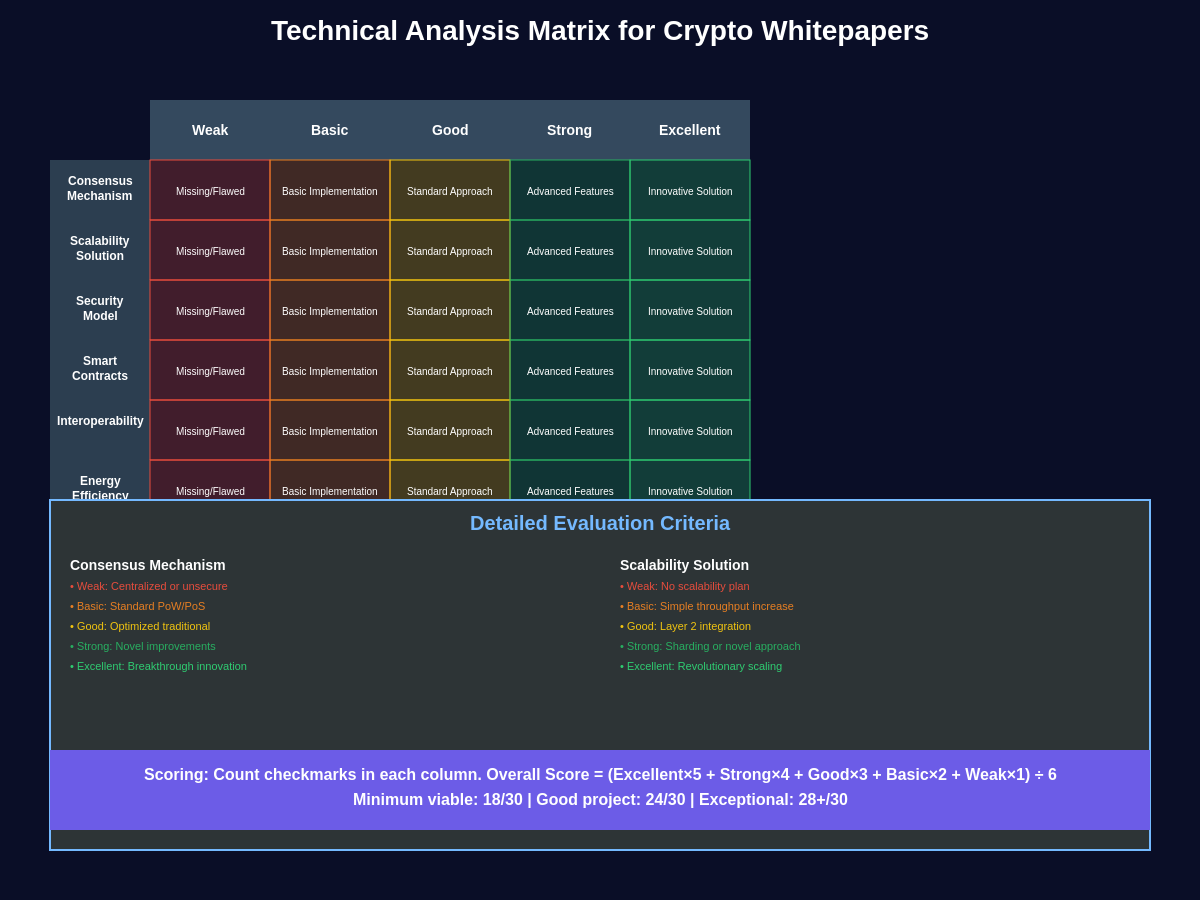Explore advanced technical analysis tools on TradingView to complement your whitepaper research with comprehensive market data and technical indicators that can validate the claims made in cryptocurrency project documentation.
The Critical Importance of Whitepaper Analysis
Cryptocurrency whitepapers serve as the foundational documents that outline the technical specifications, economic models, and strategic vision of blockchain projects, making them essential reading for anyone considering investment or participation in the cryptocurrency ecosystem. These documents provide the most comprehensive insight into a project’s technological innovation, problem-solving approach, and long-term viability, yet the majority of cryptocurrency investors never thoroughly read or analyze these critical publications before making financial commitments.
The sophistication and complexity of modern cryptocurrency projects demand a systematic approach to whitepaper evaluation that goes beyond superficial reading to encompass technical verification, economic analysis, and strategic assessment. Professional investors and institutional participants have developed rigorous frameworks for whitepaper analysis that enable them to identify promising projects while avoiding the numerous scams and poorly conceived ventures that populate the cryptocurrency landscape.
Understanding how to properly analyze cryptocurrency whitepapers represents one of the most valuable skills an investor can develop, as it provides the foundation for making informed decisions based on fundamental analysis rather than speculation or market sentiment. The ability to critically evaluate technical claims, assess economic models, and identify potential red flags can mean the difference between identifying the next breakthrough innovation and falling victim to sophisticated fraud schemes.
Understanding Whitepaper Structure and Components

Well-structured cryptocurrency whitepapers follow established academic and technical writing conventions that facilitate comprehensive analysis and evaluation by readers with varying levels of technical expertise. The most effective whitepapers begin with executive summaries that clearly articulate the problem being addressed, the proposed solution, and the key benefits that distinguish the project from existing alternatives, providing readers with a roadmap for the detailed analysis that follows.
Technical sections form the core of any serious cryptocurrency whitepaper, presenting the architectural design, consensus mechanisms, cryptographic implementations, and performance characteristics that define the project’s capabilities and limitations. These sections should include detailed diagrams, mathematical proofs where applicable, and sufficient technical detail to enable independent verification and peer review by qualified experts in the field.
Economic sections of cryptocurrency whitepapers address tokenomics, distribution models, governance structures, and incentive mechanisms that determine how the project will function as an economic system. These components are crucial for understanding whether the project has sustainable economics and whether the token serves a genuine utility purpose rather than existing solely as a speculative vehicle.
The quality of a whitepaper’s presentation, organization, and attention to detail often reflects the professionalism and competence of the development team, making document quality an important factor in overall project evaluation. Professional whitepapers demonstrate clear thinking, thorough research, and attention to detail that inspire confidence in the team’s ability to execute their technical vision.
Technical Analysis Framework for Blockchain Projects

Evaluating the technical merit of cryptocurrency projects requires a systematic framework that addresses consensus mechanisms, scalability solutions, security models, and innovative features that differentiate the project from existing blockchain implementations. The consensus mechanism represents the fundamental architectural decision that determines how the network achieves agreement on transaction validity and network state, with implications for security, decentralization, energy efficiency, and performance characteristics.
Scalability analysis involves examining how the project addresses the fundamental blockchain trilemma of balancing security, decentralization, and throughput while maintaining the essential properties that make blockchain technology valuable. Projects may employ various approaches including layer-two solutions, sharding, alternative consensus mechanisms, or novel architectural designs that require careful evaluation of their trade-offs and implementation feasibility.
Security considerations encompass cryptographic implementations, attack resistance, formal verification processes, and the overall robustness of the system against various threat vectors including economic attacks, technical exploits, and governance manipulation. The whitepaper should demonstrate a thorough understanding of potential security risks and present credible mitigation strategies backed by mathematical analysis or empirical evidence.
Innovation assessment requires evaluating whether the project presents genuine technological advancement or merely repackages existing solutions with marginal improvements, as the cryptocurrency space is filled with projects that claim breakthrough innovation while offering little substantive technical progress. Genuine innovation should be clearly articulated, technically sound, and address real limitations of existing systems rather than creating solutions in search of problems.
Professional analysis often involves cross-referencing whitepaper claims with technical indicators and market data available on advanced trading platforms to validate whether the project’s technical capabilities align with market performance and adoption metrics.
Economic Model Evaluation and Tokenomics Analysis
Cryptocurrency tokenomics represent the economic foundation that determines whether a project can achieve sustainable operation and provide genuine value to participants, making economic analysis equally important as technical evaluation when assessing whitepaper quality. Token utility analysis examines whether the native token serves essential functions within the ecosystem or exists primarily as a fundraising mechanism with artificially created demand through forced usage requirements.
Distribution models reveal important information about project governance, decentralization, and potential for manipulation by examining how tokens are allocated among founders, investors, communities, and various stakeholder groups. Fair and transparent distribution models that avoid excessive concentration of tokens among insiders demonstrate commitment to decentralization and community participation, while heavily concentrated distributions may indicate centralized control or potential for market manipulation.
Inflation and deflation mechanisms built into token economics determine the long-term supply dynamics that affect token value and ecosystem sustainability, requiring analysis of emission schedules, burning mechanisms, staking rewards, and other factors that influence token supply over time. These mechanisms should align with the project’s operational requirements and provide appropriate incentives for network participation without creating unsustainable inflationary or deflationary pressures.
Governance models outlined in whitepapers determine how decisions are made regarding protocol upgrades, parameter changes, and strategic direction, with implications for decentralization, community participation, and long-term project evolution. Effective governance mechanisms balance efficiency with decentralization while providing clear processes for community input and decision implementation.
Revenue models and value capture mechanisms explain how the project will generate sustainable income and create value for token holders, distinguishing between projects with clear paths to profitability and those that rely entirely on speculative demand. Sustainable projects typically demonstrate multiple revenue streams, clear value propositions for users, and economic models that align incentives among all participants.
Team Assessment and Credibility Verification
The quality and credibility of the development team represents one of the most critical factors in determining project success, as even the most innovative technical concepts require skilled execution and sustained development effort to achieve their potential. Team evaluation involves examining the educational backgrounds, professional experience, previous accomplishments, and track records of key team members to assess their capability to deliver on the promises outlined in the whitepaper.
Technical team assessment focuses on evaluating whether team members possess the specialized skills required for blockchain development, cryptographic implementation, distributed systems design, and the specific technical challenges outlined in the project’s technical specifications. The most credible projects feature team members with relevant academic credentials, previous blockchain experience, or demonstrated expertise in related fields such as distributed computing, cryptography, or financial systems.
Advisory board composition provides additional insight into project credibility and strategic direction, as legitimate projects often attract well-known experts, successful entrepreneurs, or industry veterans who lend their expertise and reputation to the venture. However, advisory relationships should be verified through multiple sources, as some projects falsely claim advisory relationships or exaggerate the involvement of prominent figures.
Transparency and accountability measures include public profiles, social media presence, previous project involvement, and willingness to engage with the community through conferences, interviews, and technical discussions. Teams that maintain high visibility and actively participate in the broader blockchain community demonstrate confidence in their work and commitment to transparency.
Red flags in team evaluation include anonymous teams with no track record, teams with no relevant experience, advisors who deny involvement when contacted, and teams that avoid public appearances or technical discussions about their work. While anonymous teams are not automatically disqualifying, they require additional scrutiny and stronger technical evidence to establish credibility.
Identifying Red Flags and Warning Signs

Sophisticated cryptocurrency scams often present themselves through professional-looking whitepapers that mimic the structure and language of legitimate projects while containing subtle indicators that reveal their fraudulent nature to careful analysts. Common red flags include vague or missing technical details that cannot be independently verified, unrealistic performance claims that exceed the theoretical limits of current technology, and economic models that rely on unsustainable growth assumptions or Ponzi-like structures.
Technical red flags encompass claims of solving fundamental computer science problems without adequate proof, missing implementation details that prevent independent verification, copying technical content from other projects without attribution, and proposing solutions that ignore well-known limitations or trade-offs in distributed systems design. Legitimate projects acknowledge technical challenges and present realistic approaches to addressing them rather than claiming to have solved problems that have stumped researchers for decades.
Economic red flags include token distributions that heavily favor insiders, unclear utility for native tokens that appear designed solely for speculation, unrealistic revenue projections based on optimistic adoption scenarios, and governance models that concentrate power among founders while limiting community participation. Projects with sustainable economics present realistic growth assumptions and clear value propositions that do not rely entirely on speculative demand.
Legal and regulatory red flags involve projects that fail to address regulatory compliance, attempt to circumvent securities laws through technical loopholes, operate from jurisdictions chosen primarily to avoid oversight, or make claims about regulatory approval that cannot be independently verified. Legitimate projects engage proactively with regulatory frameworks and provide clear guidance on compliance requirements.
Marketing and communication red flags include excessive focus on price speculation rather than technical development, celebrity endorsements without substantive technical backing, aggressive marketing campaigns that emphasize urgency over analysis, and community management that discourages critical questions or technical discussion. Projects focused on legitimate innovation welcome scrutiny and technical debate rather than attempting to suppress critical analysis.
Competitive Analysis and Market Positioning
Effective whitepaper analysis requires understanding how proposed projects fit within the broader cryptocurrency ecosystem and compete with existing solutions, as many projects claim to solve problems that have already been addressed by established platforms with proven track records. Competitive analysis involves identifying direct and indirect competitors, comparing technical approaches and capabilities, and evaluating whether the proposed project offers sufficient advantages to justify market entry and adoption.
Market size analysis examines whether the addressable market is large enough to support the proposed project while considering existing competitors and market saturation in the targeted sector. Many cryptocurrency projects present inflated market size estimates that ignore competition, regulatory constraints, or practical adoption barriers that limit actual market opportunity.
Differentiation analysis focuses on identifying unique value propositions that distinguish the project from alternatives, evaluating whether claimed advantages are sustainable and defensible, and assessing whether the differentiation is meaningful to target users or primarily marketing-focused. Genuine differentiation should be clearly articulated, technically sound, and address real user needs rather than creating artificial distinctions.
Partnership and integration strategies outlined in whitepapers provide insight into how projects plan to achieve adoption and integrate with existing systems, with credible projects presenting realistic approaches to business development and strategic partnerships. Announced partnerships should be verified through multiple sources, as some projects exaggerate partnership relationships or announce partnerships that lack substance.
Adoption pathway analysis examines how projects plan to transition from development to mainstream adoption, considering network effects, user acquisition costs, and the challenges of competing with established platforms that already have significant user bases and developer ecosystems. Realistic adoption strategies acknowledge these challenges and present credible approaches to overcoming them.
When analyzing competitive positioning, it’s valuable to reference comprehensive market analysis tools that provide real-time data on how similar projects are performing in terms of market capitalization, trading volume, and price trends.
Technical Due Diligence and Verification Methods

Thorough technical due diligence extends beyond reading the whitepaper to include independent verification of claims through code review, testnet analysis, academic peer review, and consultation with independent technical experts who can assess the feasibility and innovation of proposed solutions. Many cryptocurrency projects present compelling whitepapers that do not translate into working implementations, making verification of actual technical progress essential for informed evaluation.
Code review involves examining publicly available source code to verify that development progress aligns with whitepaper claims and that implementation quality meets professional standards for security, efficiency, and maintainability. Projects that maintain private repositories or provide limited code access should be viewed with skepticism, as transparency in development is a fundamental principle of decentralized systems.
Testnet participation provides hands-on experience with project functionality while allowing independent verification of performance claims, user experience quality, and technical stability under realistic conditions. Active testnets with meaningful functionality demonstrate serious development progress and provide opportunities to evaluate whether the project delivers on its promised capabilities.
Academic validation through peer review, conference presentations, or collaboration with research institutions lends credibility to technical claims and demonstrates that the project’s innovations have been evaluated by independent experts. Projects that publish research papers, present at academic conferences, or collaborate with universities typically demonstrate higher technical rigor than those that rely solely on marketing materials.
Third-party audits and security assessments provide independent verification of technical quality and security properties, particularly for projects that handle significant value or implement complex smart contract systems. Reputable audit firms provide detailed reports that identify potential vulnerabilities and verify that implementations match design specifications.
Community technical review through open source development, technical forums, and developer community engagement provides additional validation of technical merit while demonstrating the project’s ability to attract qualified contributors and maintain ongoing development momentum.
Risk Assessment and Investment Considerations
Comprehensive risk assessment for cryptocurrency projects involves evaluating technical risks, market risks, regulatory risks, and execution risks that could impact project success regardless of the quality of the underlying technology or economic model. Technical risks include the possibility of critical bugs, security vulnerabilities, scalability limitations, or fundamental design flaws that could compromise project functionality or security.
Market risks encompass competition from established platforms, changes in user preferences, market saturation, and the possibility that the problem being addressed may not require a blockchain-based solution or may be better solved through alternative approaches. Many cryptocurrency projects address problems that could be solved more efficiently with traditional technology, making market validation crucial for long-term success.
Regulatory risks involve potential government intervention, changes in legal frameworks, compliance requirements, and the possibility that regulatory developments could limit or prohibit project operations in key markets. Projects operating in heavily regulated sectors such as finance, securities, or data privacy face particularly significant regulatory risks that must be carefully evaluated.
Execution risks include team capability, funding sustainability, development timeline realism, and the possibility that technical or business challenges may prove more difficult than anticipated. Even well-designed projects can fail due to poor execution, inadequate funding, or inability to adapt to changing circumstances.
Investment considerations extend beyond risk assessment to include portfolio fit, investment timeline, liquidity requirements, and alignment with broader investment objectives and risk tolerance. Cryptocurrency investments should be considered as part of a diversified portfolio with appropriate position sizing based on individual risk tolerance and investment goals.
Professional investors often utilize advanced portfolio analysis tools to evaluate how cryptocurrency investments fit within broader investment strategies and to monitor risk exposure across different asset classes and market sectors.
Regulatory Compliance and Legal Considerations
Regulatory analysis of cryptocurrency whitepapers requires understanding how projects navigate the complex and evolving legal landscape surrounding digital assets, securities regulations, anti-money laundering requirements, and jurisdictional compliance issues that vary significantly across different countries and regulatory frameworks. Projects that fail to address regulatory considerations or attempt to circumvent existing laws through technical loopholes face significant risks of enforcement action that could compromise their long-term viability.
Securities law compliance represents one of the most critical regulatory considerations for cryptocurrency projects, as many tokens may be classified as securities under existing regulatory frameworks, subjecting them to registration requirements, disclosure obligations, and restrictions on marketing and distribution. Projects should demonstrate clear understanding of securities law implications and present credible approaches to compliance that do not rely on untested legal theories.
Anti-money laundering and know-your-customer requirements affect projects that facilitate financial transactions or provide services that could be used for illicit activities, requiring implementation of compliance programs that balance regulatory requirements with privacy and decentralization objectives. Projects operating in the financial services sector must demonstrate understanding of these requirements and present realistic approaches to compliance implementation.
Cross-border regulatory considerations involve understanding how projects will comply with regulations in multiple jurisdictions while avoiding conflicts between different regulatory frameworks that could limit operational flexibility or market access. Projects with global ambitions must navigate complex regulatory environments that may have conflicting requirements or restrictions.
Legal structure and governance arrangements outlined in whitepapers provide insight into how projects plan to organize their operations, manage legal risks, and provide accountability to token holders and other stakeholders. Well-structured projects typically establish clear legal entities, governance frameworks, and compliance programs that demonstrate professional approach to legal and regulatory requirements.
Future Development Roadmap Analysis
Roadmap evaluation involves assessing whether proposed development timelines are realistic, whether milestones are specific and measurable, and whether the project demonstrates understanding of the technical and operational challenges involved in executing their vision. Unrealistic roadmaps that promise rapid development of complex features or ignore known technical challenges indicate poor planning or lack of technical understanding.
Milestone specificity and measurability enable objective evaluation of development progress and provide accountability mechanisms for the development team, while vague or unmeasurable milestones make it difficult to assess whether the project is meeting its commitments. High-quality roadmaps include specific deliverables, success metrics, and dependency relationships between different development phases.
Resource allocation and funding sustainability analysis examines whether the project has adequate financial resources to execute their development plan and whether their funding model provides sustainable revenue streams to support long-term development and operations. Projects that rely entirely on initial token sales without sustainable revenue models may struggle to maintain development momentum over time.
Adaptability and flexibility considerations evaluate whether roadmaps allow for adjustment based on technical discoveries, market feedback, or changing competitive conditions, as rigid roadmaps that cannot accommodate new information or changing circumstances may indicate inflexible thinking or poor project management capabilities.
Community and ecosystem development plans demonstrate understanding that successful blockchain projects require more than technical development, encompassing user acquisition, developer ecosystem building, partnership development, and community engagement strategies that are essential for achieving meaningful adoption and network effects.
Long-term Sustainability and Vision Assessment
Sustainability analysis extends beyond technical and economic considerations to encompass the project’s long-term vision, adaptability to changing market conditions, and ability to maintain relevance as the cryptocurrency ecosystem evolves. Projects with sustainable long-term prospects typically demonstrate clear understanding of their role within the broader blockchain ecosystem and present credible strategies for maintaining competitiveness over time.
Vision coherence and consistency evaluation examines whether the project’s stated goals align with their technical approach, economic model, and operational strategy, while identifying potential contradictions or unrealistic expectations that could undermine long-term success. Coherent visions demonstrate clear thinking about the project’s purpose and realistic understanding of the challenges involved in achieving their objectives.
Ecosystem development and network effects analysis evaluates whether the project has potential to create positive feedback loops that drive adoption and value creation over time, as the most successful blockchain projects typically benefit from network effects that make them more valuable as they grow larger. Projects that fail to demonstrate clear network effects or ecosystem development potential may struggle to achieve sustainable competitive advantages.
Technology evolution and upgrade capability assessment examines whether the project architecture allows for future improvements and adaptations to changing requirements, as the blockchain technology landscape continues to evolve rapidly and projects must be able to incorporate new developments to remain competitive.
Community governance and decentralization progression plans evaluate whether projects have credible strategies for transitioning from centralized development to decentralized governance while maintaining operational effectiveness and strategic coherence. Successful decentralization requires careful planning and gradual transition processes that balance efficiency with community participation.
Practical Application and Investment Integration
Implementing whitepaper analysis within broader investment processes requires developing systematic evaluation frameworks that can be applied consistently across different projects while accounting for varying project types, development stages, and risk profiles. Professional investors typically develop standardized evaluation criteria that enable objective comparison between different investment opportunities while maintaining flexibility to account for unique project characteristics.
Portfolio integration considerations involve evaluating how potential cryptocurrency investments fit within broader investment strategies, risk tolerance parameters, and diversification objectives, as cryptocurrency investments should complement rather than replace traditional asset allocation strategies. Position sizing decisions should reflect the speculative nature of most cryptocurrency investments and the potential for significant losses.
Ongoing monitoring and evaluation processes ensure that investment decisions remain valid as projects evolve, market conditions change, and new information becomes available, requiring systematic approaches to tracking development progress, competitive developments, and regulatory changes that could affect investment outcomes.
Exit strategy planning involves establishing clear criteria for both profit-taking and loss mitigation based on project performance, market conditions, and changing investment objectives, as the volatile nature of cryptocurrency markets requires disciplined approaches to position management and risk control.
Due diligence documentation and record-keeping practices enable systematic evaluation of investment performance and decision-making processes while providing accountability mechanisms that support continuous improvement in analysis techniques and investment outcomes.
For comprehensive market analysis to support whitepaper evaluation, professional investors often utilize advanced technical analysis platforms that provide detailed market data, technical indicators, and analytical tools necessary for making informed investment decisions based on both fundamental analysis of project whitepapers and technical analysis of market trends.
Disclaimer: This article is for educational purposes only and does not constitute financial advice. Cryptocurrency investments carry significant risks, including the potential for total loss of capital. Always conduct thorough research and consult with qualified financial professionals before making investment decisions. Past performance does not guarantee future results, and the cryptocurrency market is highly volatile and speculative.